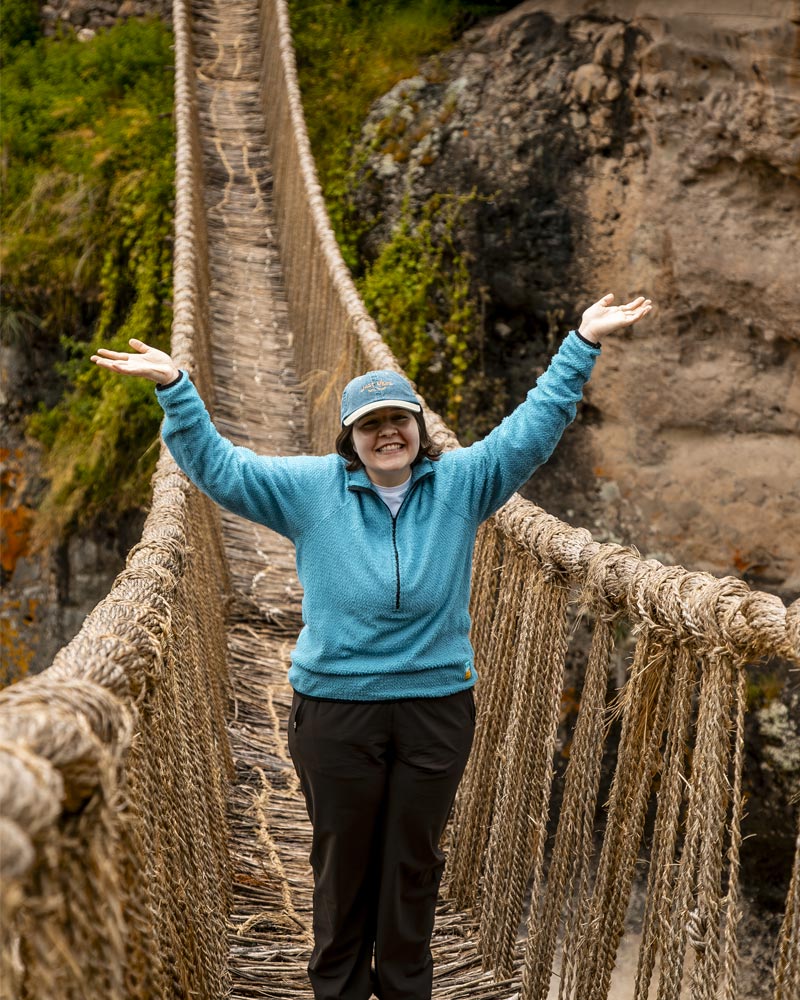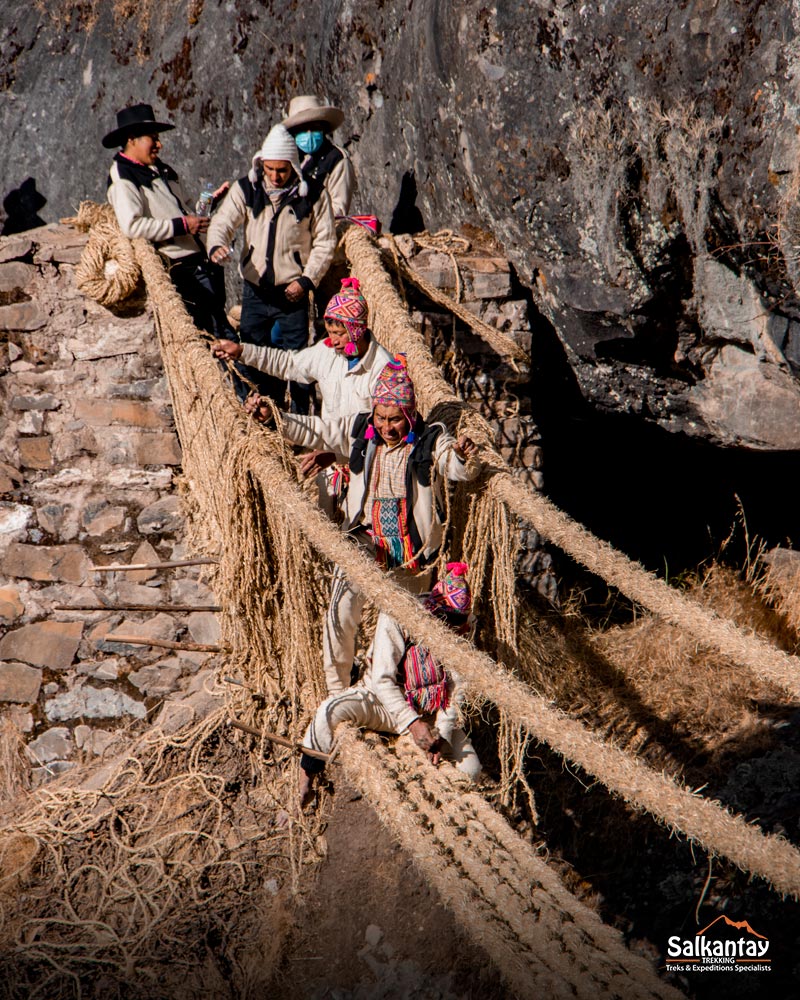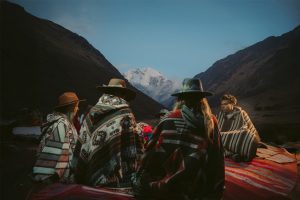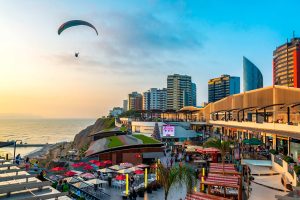Q’eswachaka, the last Inca bridge, is a magnificent rope bridge that soars majestically over the Apurímac River. It’s much more than a mere structure, it is a living link to the grandeur of the Incas and an entrenched tradition that has endured for over 600 years.
Every year, with unwavering dedication, members of the local communities gather to reconstruct this bridge just as it was done in ancient times. Imagine the collective effort of around 800 people, united by their commitment to preserving their cultural heritage.
More than being just a means to cross the river, the Qeswachaka Bridge holds profound significance for the locals. It is a tangible symbol of their ancestral traditions, a connection to the glorious past of the Incas, and a source of community pride. In this blog, we invite you to immerse yourself in the grandeur of a tradition that defies the passage of time and marvels at the greatness of the Q’eswachaka Bridge.
Discover this incredible inca bridge in Cusco!
What does Q’eswachaka mean?
“Q’eswachaka” is a word that comes from the Quechua language and consists of two parts: “Q’eswa,” which means “rope” or “cord,” and “Chaka,” which means “bridge.” Therefore, “Q’eswachaka” translates to “rope bridge” or “hanging bridge.”
This bridge is an exceptional example of the ancient Inca suspension bridges that were constructed using traditional techniques and materials. It has been preserved and rebuilt for centuries by local communities, maintaining its connection to the Inca cultural heritage.
The result is an engineering marvel measuring 28 meters long and 1.2 meters wide, standing as a living testament to the skill and wisdom of their ancestors. In fact, it is recognized as the last remaining Inca bridge, making it an invaluable treasure for both the local communities and curious visitors.


How the Q’eswachaka Bridge Is Built
Every June, four communities come together for four days to rebuild the Q’eswachaka Bridge, keeping alive an Inca tradition that has endured for centuries. Through teamwork, ancestral knowledge, and natural fibers, they breathe new life into this hanging bridge over the Apurímac River.
The ropes are made from a plant fiber called q’oya, which grows in high and humid areas of the Andes. This plant belongs to the same family as ichu, a type of grass typical of the Andean highlands. Both fibers are incredibly strong, making them the perfect material to support the weight of those who cross the hanging bridge.
After being cut, the q’oya is laid out in the sun to dry. The next day, the bundles of straw are pounded with stones, which gives the fiber flexibility for handling without losing its strength. For the bridge renewal festival, each family is tasked with making a long rope.
We explain in more detail how this important ritual unfolds.


Day 1: Permission from the Apus
The first day begins with a sacred ceremony at dawn. An offering is made to Apu Quinsallallawi, the protective spirit of the mountains, just as the ancestors used to do. This ceremony seeks permission from the Apus (sacred mountains, considered protective deities and sources of energy) so that the reconstruction of the bridge will be successful and last until the following year. Meanwhile, the women of the community begin braiding and tying the q’oya fibers, creating the ropes that will shape and support the bridge.
Day 2: Farewell to the Old Bridge
On the second day, the old bridge is dismantled. Participants carefully remove the ropes and wooden sections that make up the structure of the old bridge. Next, all the cords previously braided by the women are intertwined. These are bundled and twisted together to create large ropes (called Makis) that will serve as support and become the main foundation of the new bridge’s structure.


Day 3: Weaving the New Bridge in the Air
This is the most intense and exciting day of the restoration, the heart of the process. The bridge’s floor is constructed and the railings are placed on both sides, in hard work performed by the artisans suspended over the rushing Apurímac River. It is striking to see the men working over the void, without any safety support, relying solely on their experience, balance, and collective strength.
This process requires a deep mastery of traditional techniques passed down through generations. The ropes, handmade in the previous days, are carefully intertwined to form a solid and strong base.
Every knot, every braid, is an act of precision that binds not only fibers but also centuries of living history.
Day 4: The Grand Celebration at the Q’eswachaka Bridge
On the last day, final touches and thorough tests are carried out to ensure the bridge is ready and safe for use. Once completed, they celebrate the completion of their project with abundant food and regional dances. These four days of restoration are not only a physical and technical effort but also an opportunity to strengthen community bonds and keep an invaluable tradition alive.

How to get to the Q’eswachaka Bridge
The Q’eswachaka Bridge is located south of the Cusco region, specifically in the Canas province, Quehue district. It is suspended over the Apurímac River, more than 3,700 meters (12,139 feet) above sea level, in a rural setting surrounded by mountains and Quechua communities that keep their ancestral traditions alive.
Getting to this Inca bridge from Cusco takes about 4 hours. Although the journey is long, the views are breathtaking and make it worthwhile. There are two ways to visit the bridge and experience its wonder and incredible craftsmanship.


Getting to Q’eswachaka on Your Own
This option is a bit more complicated, but many travelers prefer it because of the freedom it offers.
The first step is to find a taxi driver who knows the route well. Not all do, so it’s best to ask for a recommendation at your hotel or hostel; they usually know trustworthy drivers. The trip from Cusco to the town where the bridge is located takes about 3-4 hours by road. Once there, you’ll have time to cross the hanging bridge and calmly enjoy the surroundings, take photos, and live the experience. It’s recommended to bring your own food, especially if you have allergies or special dietary needs, as the local options can be limited and very basic.
And for the return? Don’t forget to negotiate with the taxi driver to wait for you and take you back to Cusco. For this full-day service, you can expect to pay around 200 soles.
Getting to Q’eswachaka with a Tour Agency
Traveling with a tour agency is not only more comfortable, but in this case, it can even be more economical. The last Inca bridge, Q’eswachaka, is quite far from Cusco, and there is no public transportation that goes there. Hiring a private taxi can be expensive, and organizing it on your own requires time and planning.
By choosing an agency, you forget about the logistical details: transportation, food, and entrance fees are included. In addition, you will have a professional guide who will explain the history and significance of the bridge and will ensure your safety throughout the trip. Salkantay Trekking offers a one-day tour to the Q’eswachaka bridge that includes all this. But you won’t just visit the bridge: on the way, you will also stop at four stunning turquoise lagoons and the birthplace of Túpac Amaru II, an Andean hero who led the largest indigenous rebellion against the Spanish colony.
A complete cultural and natural experience for those who want to explore the heart of the Andes without complications.

The Last Inca Bridge of Cusco Awaits You
If you are in Cusco and have time, we recommend reserving a day of your trip to visit the impressive Qeswachaka Bridge. It is an enriching experience that immerses you in cultural richness and allows you to appreciate the dedication and love with which the community cares for and preserves its heritage.
As you walk across the bridge, you will feel the energy and history flowing through its ropes and pillars. Admire the careful craftsmanship and teamwork needed to keep this architectural marvel standing. Dare to discover what few have seen and treat yourself to a memorable day exploring the Q’eswachaka Bridge.
We guarantee you will take away unforgettable memories and a deeper appreciation for the ancestral heritage of the Incas.











Leave A Reply